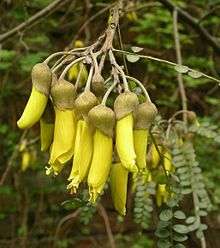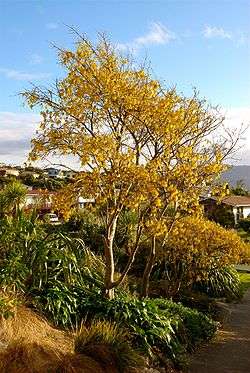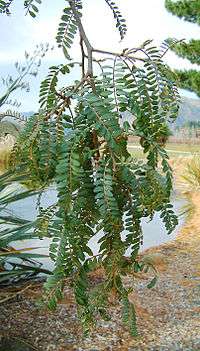Kōwhai
Kōwhai (Māori pronunciation: [kɔːɸai] or [kɔːfai]) are small woody legume trees within the genus Sophora that are native to New Zealand. There are eight species, with Sophora microphylla and S. tetraptera being the most recognised as large trees. Their natural habitat is beside streams and on the edges of forest, in lowland or mountain open areas.[1] Kōwhai trees grow throughout the country and are a common feature in New Zealand gardens. Outside of New Zealand, kōwhai tend to be restricted to mild temperate maritime climates.

The blooms of the kōwhai are widely regarded as being New Zealand's national flower,[2] although they have no official status as such.[3]
The word kōwhai is also used in the Māori language for the colour yellow, because of the colour of the flowers.[4]
The spelling kowhai (without a macron) is common in New Zealand English.
Species

The eight species of kōwhai are:
- Sophora chathamica, coastal kōwhai
- Sophora fulvida, Waitakere kōwhai
- Sophora godleyi, Godley's kōwhai
- Sophora longicarinata, limestone kōwhai
- Sophora microphylla, small-leaved kōwhai
- Sophora molloyi, Cook Strait kōwhai
- Sophora prostrata, prostrate kōwhai
- Sophora tetraptera, large-leaved kōwhai[5][6]
Description and ecology

_(14781835954).jpg)
Most species of kōwhai grow to around 8 m high and have fairly smooth bark with small leaves. S. microphylla has smaller leaves (0.5–0.7 cm long by 0.3–0.4 cm wide) and flowers (2.5–3.5 cm long) than S. tetraptera, which has leaves of 1–2 cm long and flowers that are 3–5 cm long.
The very distinctive seed pods that appear after flowering are almost segmented, and each contains six or more smooth, hard seeds. Most species have yellow seeds, but Sophora prostrata has black ones. The seeds of Sophora microphylla can be very numerous and the presence of many hundreds of these distinctively yellow seeds on the ground quickly identifies the presence of a nearby kōwhai tree. Many species of kōwhai are semi-deciduous and lose most of their leaves immediately after flowering in October or November, but quickly produce new leaves. Flowering of kōwhai is staggered from July through to November, meaning each tree will get attention from birds such as tui, wood pigeon and bellbird.[7] Tui are very attracted to kōwhai and will fly long distances to get a sip of its nectar.
The wood of kōwhai is dense and strong and has been used in the past for tools and machinery.[1]
Sophora is one of the four genera of native legumes in New Zealand; the other three are Carmichaelia, Clianthus, and Montigena.[6]
Cultivation
Kōwhai can be grown from seed or tip cuttings in spring and autumn.[8] The dark or bright yellow seeds germinate best after chitting and being soaked in water for several hours. They can also benefit from a several minute submersion in boiling water to soften the hard shell and then being kept in the same water, taken off boil, for several hours to soak up the water.[9] Young kōwhai are quite frost tender, so cuttings or seedlings should be planted in their second year when they are 30 cm or higher.[10]
If grown from seed, kōwhai can take many years to flower, the number of years varies depending on the species.[11]
S. prostrata, sometimes called "little baby", is used as a bonsai tree. It grows up to two metres high, has zigzagging stems, and sparse smallish leaves.[12]
Dangers
All parts of the kōwhai, but particularly the seeds, are poisonous to humans.[13] However, there do not appear to have been any confirmed cases in humans of severe poisoning following ingestion of kōwhai in New Zealand.[14]
Traditional Māori use
Traditionally the Māori used the flexible branches as a construction material in their houses and to snare birds. The kōwhai flowers were a source of yellow dye. Also, when the kowhai flowers bloom, in late winter and early spring, it is time to plant kumara (sweet potato). [15]
Māori also used the kōwhai tree as medicine. The bark was heated in a calabash with hot stones, and made into a poultice to treat wounds or rubbed on a sore back[16] or made into an infusion to treat bruising or muscular pains.[17] If someone was bitten by a seal, an infusion (wai kōwhai) was prepared from kōwhai and applied to the wounds and the patient was said to recover within days.[16]
References
- Poole, Alec Lindsay (1966). "Kowhai". An Encyclopaedia of New Zealand. Retrieved 8 September 2012.
- "Kowhai" in New Zealand A to Z.
- "Nationhood and identity", in Te Ara Encyclopedia of New Zealand.
- "kōwhai". Te Aka.
- "Sophora". Integrated Taxonomic Information System.
- The Current Taxonomy of New Zealand Legumes
- Kirsten L. Campbell (2006). A study of home ranges, movements, diet and habitat use of kereru (Hemiphaga novaeseelandiae) in the southeastern sector of Banks Peninsula, New Zealand (Thesis). Lincoln University. hdl:10182/347.
- "Native Plants at Piha". Archived from the original on 2008-10-14. Retrieved 2009-01-17.
- "Archived copy". Archived from the original on 2008-10-14. Retrieved 2009-05-21.CS1 maint: archived copy as title (link) Raising Native Plants From Seed
- "Trees for Survival". Archived from the original on 2009-02-08. Retrieved 2009-01-17.
- "Years for kowhai to flower".
- "Sophora—The Kowhais of New Zealand" (PDF). Retrieved 2008-11-05.
- "Poisonous Plants at the Royal New Zealand Institute of Horticulture". Retrieved 2008-05-20.
- Slaughter, Robin; Beasley, Michael; Lambie, Bruce; Wilkins, Gerard; Schep, Leo (2012). "Poisonous plants in New Zealand: a review of those most commonly enquired about to the National Poisons Centre". The New Zealand Medical Journal. Archived from the original on 2013-01-09. Retrieved 2013-03-27.
- "Sophora microphylla (Kowhai)". Taranaki Educational Resource: Research, Analysis and Information Network. Retrieved 31 August 2012.
- Jones, Rhys (2 March 2009). "Rongoā – medicinal use of plants – Other medicinal plants". Te Ara – the Encyclopedia of New Zealand. Retrieved 8 November 2010.
- Durie, Sir Mason (2010). "Te whakahaumanutanga me te oranga hinengaro o mua – Ka mātaia ngā huanga o te rongoā – Traditional healing and mental health: measuring the effectiveness of rongoā" (PDF). Best Practice Journal. Best Practice Advocacy Centre. June (28): 5–7.